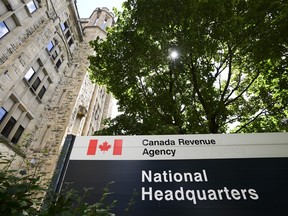Jamie Golombek: Study shows how much additional revenue CRA would have received if individuals and companies reported income properly

Reviews and recommendations are unbiased and products are independently selected. Postmedia may earn an affiliate commission from purchases made through links on this page.
Article content
Canada’s “tax gap” has remained relatively stable at nine per cent of federal tax revenues even though the total amount of the shortfall grew over a five-year period, according to a new report issued by the Canada Revenue Agency on Tuesday.
Advertisement 2
Article content
The tax gap represents the difference between the total amount of taxes that would be paid if every Canadian individual and corporation fully reported all their income properly (including income from the underground economy), took only appropriate expense deductions and properly claimed only the tax credits to which they were entitled compared to the tax actually paid and collected by the Canada Revenue Agency. In short, it’s a measure of the potential loss of tax revenue resulting from tax non-compliance.
The new report shows that for 2018, Canada’s federal “gross” tax gap was estimated to be between $35.1 billion to $40.4 billion before taking into account the CRA’s compliance and collection activities. Through those ongoing audit and collection efforts, the CRA is expected to ultimately reduce the gap to between $18.1 billion to $23.4 billion, or approximately seven to nine per cent of federal tax revenue. This percentage has been fairly stable over a five-year period, even as Canada’s federal tax revenues haven risen to $272 billion (2018-2019 fiscal year) from $237 billion (2014-2015). The gap in 2014 ranged from $15 billion to $19.1 billion.
Advertisement 3
Article content
In calculating the tax gap, there are two main forms of non-compliance: reporting non-compliance and payment non-compliance. Reporting non-compliance is when taxpayers fail to provide complete or accurate information on their tax returns by under-reporting income or claiming deductions or credits to which they are not entitled. Payment non-compliance occurs when assessed taxes are not fully paid on time by taxpayers for a particular tax year.
During tax years 2014 to 2018, around 80 per cent of the total gross tax gap was related to reporting non-compliance while the other 20 per cent was related to payment non-compliance. Drilling down deeper on the personal income tax gap, around 70 per cent was related to reporting non-compliance and 30 per cent was related to payment non-compliance. For corporations, 95 per cent was related to reporting non-compliance and five per cent was related to payment non-compliance.
Advertisement 4
Article content
The genesis of the CRA’s tax gap studies was in response to an October 2016 report of the House of Commons Standing Committee on Finance on tax avoidance and tax evasion which recommended that the CRA calculate Canada’s federal tax gap and provide information about the size of that gap and how it was calculated.
The first report, published in June 2016, looked at the tax gap for the Goods and Services Tax/Harmonized Sales Tax. Since then, the CRA has published reports annually, each one estimating different tax gap components: personal income tax, international tax gap for personal income tax, corporation income tax, excise gap and payment gap.
The new report, entitled The Overall Federal Tax Gap, brings together all previously published tax gap components with updated estimates and key findings up to the fiscal year 2018. A companion piece titled Methodological Annex gets into the nuts and bolts of how the tax gap was calculated.
Advertisement 5
Article content
-

Claiming a foreign tax credit proves to be a bit dicey for one taxpayer
-

Taxpayer hit with a TFSA overcontribution penalty takes the CRA to court
-

How the CRA divvies up the Canada Child Benefit for parents who share custody
-

CRA rules on whether two workplace perks are taxable employee benefits or not
According to Dr. Kelly Taylor, the director general of the Research and Innovation Lab Directorate (RILD) at the CRA: “This work on tax gap estimation helps us to understand where and how and why people aren’t able to pay their taxes. Ultimately that helps us to protect the integrity of the tax system. And, more importantly, protect the tax revenue base. And that revenue base is critical for the well-being of Canadians.”
Advertisement 6
Article content
Of course, one area that has not yet been studied is the effect of the COVID-19 pandemic on the tax gap. The CRA has recently sent out Notices of Redetermination, advising some Canadians who may have received COVID benefit payments for which they may have not qualified, of debts that have been established on their CRA accounts. Whether the CRA is ultimately able to collect these debts, however, may not be known for years.
“As we move forward, we will be considering the impacts of COVID-19 on the tax gap estimation,” says Taylor, emphasizing that the CRA has tried to “put people first,” employing an “empathetic” framework to the collection of amounts owing in the aftermath of COVID. “But at the same time our goal, and the tax gap estimation, is really about being able to minimize about tax gap,” adds Taylor.
Jamie Golombek, CPA, CA, CFP, CLU, TEP is the managing director, Tax & Estate Planning with CIBC Private Wealth in Toronto.
